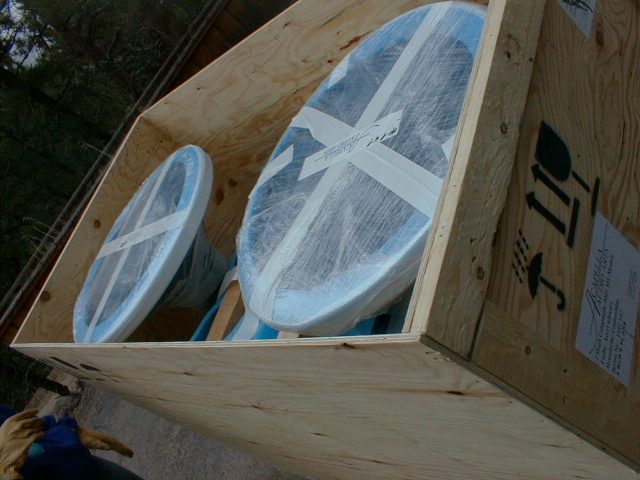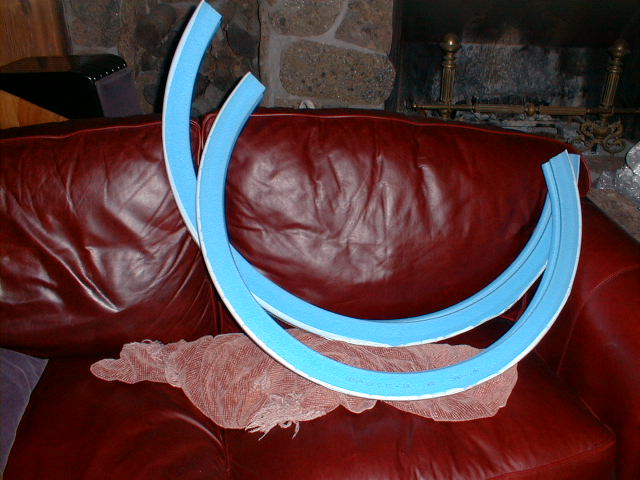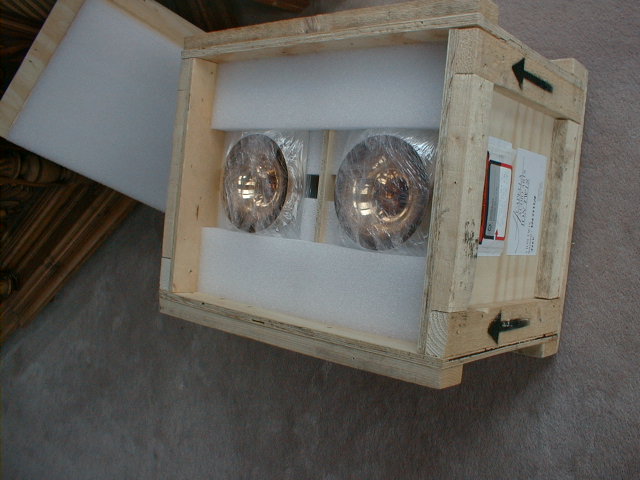The Acapella Campanile Loudspeakers
Uncrating, Unpacking, and Setup
|

Crates #2 and #3. |
The Campaniles are shipped from Germany in 3 wooden crates:
1. A small (approximately: 1ft x 1ft x 1.5 ft, 60-70 lbs.) crate
containing both tweeters
2. A large squat crate (approximately: 5 - 6 ft wide x 3 - 4 ft deep
x 4 - 5 ft tall, 300 - 400 lbs.) containing the middle section
(horn) units, manuals, brochures, parts, covers)
3. A large tall crate (approximately: 3 ft wide x 4 feet deep x 5 ft
tall, approximately 700 lbs.) containing all 4 woofer units in their
own cardboard boxes.
|

Crate #1 containing the tweeters. |
|

Crate #2 with the top off. |
Opening crate #2
Option 1:
a. Undo all screws in the top and lift the top off of the crate.
b. Undo screws in the central area of sides 1 and 3 (the long sides
which are the only sides that have any screws in the central area of
the crate) and lift out the following parts:
1. The top screws attach to a substantial piece of wood that holds
the manual and the horns in place
2. the bottom screws attach to a less substantial piece of wood that
holds down the speaker covers underneath the manuals
c. Undo screws all along the bottom of all 4 sides and lift all 4
sides as one unit off the crate. The horn units are now exposed and
can be lifted up off the crate after using scissors to cut away some
packing tape holding them down to their bed of foam
|

Crate #2 overhead view. |
Option 2:
a. Undo all the screws in all sides of the crate, both at the bottom
and in the sides themselves and lift off the crate top including its
sides all as one unit
We have used and will continue to use option 1, as it is easier to
see what is happening and one can directly observe if the unit is
packed slightly differently than as described above.
Opening crate #3
a. Remove all the screws in both sides which are opposite each other
and are the only ones that have screws to remove. It is actually
possible to now remove the top and 2 remaining sides as one unit up
off the crate
b. Remove the top speaker box that is lying on it's side top of the
other 3 (which are standing up normally)
c. Remove the other speakers boxes. |

The midrange units in their many layers of saran wrap (cellophane). |
|

A woofer unit immediately after removal from its box. |
1. Unpacking the woofer units is done using the common
methodology:
a. Open the 'top'
b. Carefully turn over the box until it is upside down
c. Pull the box up off the speaker
Note that the speaker boxes and units are labeled: Unten
(meaning 'down' or 'under') and Oben ('above' or
'over'). Google has a German to English translator that was quite
useful at:
http://translate.google.com/translate_t. |

Close up of the horn rim padding. |
|

The horn rim padding after removal from the horn |
We are keeping these around for when we want to move the
Campaniles in the future. |

The (white) box of screws to hold the tops and bottom units to the
middle
unit and (dealers only) a box of extra tubes for the tweeter
amplifiers. |
|

The opened box of tweeters. |
The tweeters weigh about 25-30lbs each, the box about 10 lbs.
This is a nice packing job. We are keeping the box and packing
material for transporting the tweeters in the future. |

The power cord(s) are in the box beneath the tweeters. |
The only way I found to get the tweeters out was to force my
fingers into the foam next to the tweeter itself, and pull up hard
on the small ridge/lip around its edge. The power cords 'male'
connector is of European style (even though the tweeter is set to
run at 110 volts). We had to go to the hardware store to buy an
adapter (Neli did not want me to 'hack'/cut the cord and physically
remove the European male and replace it with an American one). |

The diagram on the inside of the back panel of the midrange units. |
|

With the back panel off, the speaker connectors and the back of the
tweeter unit. |
The speaker connection points are robust and support spades and
banana connectors. A tweeter connector is supplied with and comes
already connected to the midrange unit crossover.
The tweeter is located about 12 - 16 inches from the back of the
speaker so one has to reach around and inside the speaker to toggle
the tweeter reset (automatic /manual) switch. |

In preparation for the final lift of the top bass unit on top of the
stack. |
The top and bottom bass units are, we estimate, about 175 lbs.
for the High Campanile (Campanile Plus) - which is probably about 65
- 75 lbs. heavier than that for the ordinary Campanile. We took a
3 stage approach to getting these up on top of the midrange unit.
The first 2 were relatively easy. The last stage required 2 strong
people to push up using their palms similar to a barbell overhead
press with 2 other people guiding the speaker, making sure it did
not tip over.
Another, untried approach, might be to assemble the top unit to
the midrange unit, and lift the pair onto the top of the bottom
unit. Heavier, yes, but the lower height required for the lift is
more within the power/strength curve of the average person.
Note that the midrange unit weighs more on one side than another.
This:
1. causes the entire speaker to 'lean' a bit on thickly padded
carpet
2. makes it a little awkward to lift the midrange unit. |

There be Campaniles here! |
Final Notes: The cords are not 'polarized' in any visible way
that I could ascertain. We had trouble with one of the tweeters not
coming on when supplied power. When I pulled the plug out and turned
it around, it came on immediately. Coincidence? Perhaps.
An electric screw driver is HIGHLY recommended.
A sharp pair of scissors is HIGHLY recommended. |